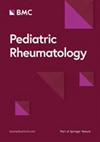The clinical relevance of different antiphospholipid antibody profiles in pediatric rheumatology patients
IF 2.8
3区 医学
Q1 PEDIATRICS
引用次数: 0
Abstract
The clinical relevance of different antiphospholipid antibody (aPL) profiles, including low level anticardiolipin (aCL) and anti-β2-glycoprotein-I (aβ2GPI) antibodies, is ill-defined in the pediatric population. Our purpose is to describe the demographic, clinical, and laboratory characteristics of aPL positive pediatric patients based on different aPL profiles. In this single center retrospective cohort study, based on the screening of our pediatric (age ≤ 18) rheumatology electronic medical records (2016–2022), we identified patients who had at least one “positive” aPL (lupus anticoagulant [LA], aCL IgG/M, or aβ2GPI IgG/M) result. Patients were grouped into high- (LA positive and/or aCL/aβ2GPI IgG/M > 40U [ELISA]) and low-risk (LA negative and aCL/aβ2GPI IgG/M 20-39U) aPL profiles; those with persistently positive aPL were descriptively analyzed for demographic and clinical characteristics. Of 57 included patients, 34 (59%) had initial high- and 23 (40%) had initial low-risk profiles. Based on subsequent aPL results available in 42/57 (74%) patients, 25/27 (93%) in the high-, and 7/15 (47%) in the low-risk groups remained still positive. Of these 32 patients with persistently positive aPL, moderate-to-large vessel or microvascular thrombosis occurred in nine (28%) patients with high-risk and in none with low-risk aPL profiles; non-thrombotic aPL-related manifestations were reported in 15 (47%) patients with persistent aPL positivity. An initial high-risk aPL profile was persistent in approximately 90% of our cohort, a third of whom had thrombosis, and half had non-thrombotic aPL manifestations. Our results underscore the need for a large-scale effort to better characterize aPL-related manifestations in pediatric patients with persistent high-risk aPL-profiles.儿科风湿病患者不同抗磷脂抗体谱的临床意义
不同的抗磷脂抗体(aPL)特征,包括低水平抗心磷脂(aCL)和抗β2-糖蛋白-I(aβ2GPI)抗体,在儿科人群中的临床意义尚不明确。我们的目的是根据不同的 aPL 特征描述 aPL 阳性儿科患者的人口统计学、临床和实验室特征。在这项单中心回顾性队列研究中,我们根据对儿科(年龄小于 18 岁)风湿病学电子病历(2016-2022 年)的筛查,确定了至少有一项 aPL(狼疮抗凝物 [LA]、aCL IgG/M 或 aβ2GPI IgG/M)结果为 "阳性 "的患者。将患者分为高风险(LA 阳性和/或 aCL/aβ2GPI IgG/M > 40U [ELISA])和低风险(LA 阴性和 aCL/aβ2GPI IgG/M 20-39U)aPL 组;对 aPL 持续阳性的患者进行人口统计学和临床特征描述性分析。在纳入的 57 名患者中,34 人(59%)具有初始高风险特征,23 人(40%)具有初始低风险特征。根据 42/57 例(74%)患者的后续 aPL 结果,高风险组中有 25/27 例(93%)和低风险组中有 7/15 例(47%)仍然呈阳性。在这 32 名 aPL 持续阳性的患者中,9 名(28%)aPL 高危患者和 0 名(47%)aPL 低危患者出现了中至大血管或微血管血栓;15 名(47%)aPL 持续阳性患者出现了非血栓性 aPL 相关表现。我们的队列中约有 90% 的患者最初的高风险 aPL 阳性持续存在,其中三分之一的患者出现血栓,一半的患者出现非血栓性 aPL 表现。我们的研究结果表明,有必要开展大规模研究,以更好地描述具有持续高风险 aPL 特征的儿科患者的 aPL 相关表现。
本文章由计算机程序翻译,如有差异,请以英文原文为准。
求助全文
约1分钟内获得全文
求助全文
来源期刊

Pediatric Rheumatology
PEDIATRICS-RHEUMATOLOGY
CiteScore
4.10
自引率
8.00%
发文量
95
审稿时长
>12 weeks
期刊介绍:
Pediatric Rheumatology is an open access, peer-reviewed, online journal encompassing all aspects of clinical and basic research related to pediatric rheumatology and allied subjects.
The journal’s scope of diseases and syndromes include musculoskeletal pain syndromes, rheumatic fever and post-streptococcal syndromes, juvenile idiopathic arthritis, systemic lupus erythematosus, juvenile dermatomyositis, local and systemic scleroderma, Kawasaki disease, Henoch-Schonlein purpura and other vasculitides, sarcoidosis, inherited musculoskeletal syndromes, autoinflammatory syndromes, and others.
 求助内容:
求助内容: 应助结果提醒方式:
应助结果提醒方式:


